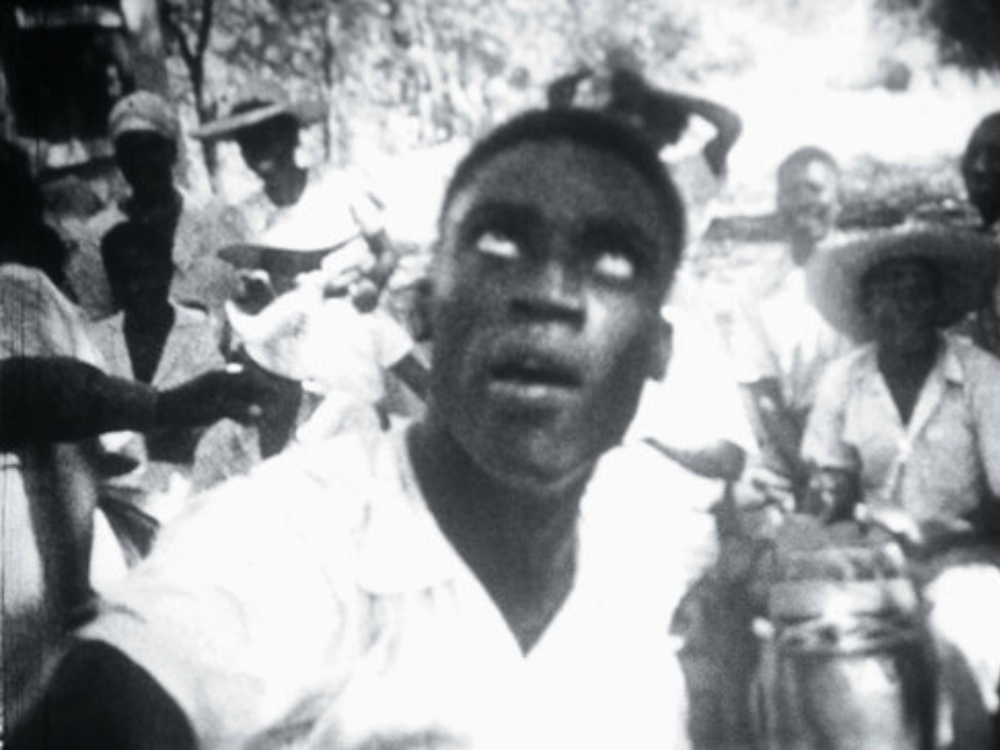At the wall in the back of the space rests an altar surrounded by oyster shells, pearls, pumpkin seeds, white candles on white cloth, white gloves, a brown fedora, a box of pralines, a Precious Moments angel. An audience member approaches and places a stem of white tuberose beside a bottle of Kahlua and the candles that flicker in the first cool September night. The wall behind is adorned with family photos, newspaper clippings, holy images and a photo of James Baldwin. Even before the performance begins, the archive and the altar have transported the audience into the sacred realm of The Horse by choreographer and dancer Chris Emile.
The 45-minute performance is presented by LAND (Los Angeles Nomadic Division) and features Emile in collaboration with sound architect Cody Perkins, vocalist Alevonallure, and West African drummers guided by Vodun practitioners. The show’s title refers to the Vodoun concept that the body is the “horse” that the inhabiting deity “rides.” The piece references ancestral knowledge and grief. Ancestors known, loved and gone, but still carried in the body. The spirituality of Vodun carried on by the Black diaspora; how tradition and ritual can be summoned for healing, how performed ritual brings catharsis for the observer too.
A circle of sod lit by a purple spotlight comprises the performance area. The piece begins with the sound of water. A trio of drummers and vocalist shrouded in white veils step onto the performance area followed by Emile veiled and clothed in roughly tied on white fabric reminiscent of a rag doll or a religious pilgrim. The dance begins subtly; Emile shuffles, turns slowly in the space, dragging his feet. At times Emile interacts with the vocalist, seemingly affected–or, perhaps, bothered–by their voice. There’s a feeling of being in purgatory and Emile is a lost soul or shade.
As the performance continues the trancelike music deepens and whips up, along with the drummers and the haunted keening from the vocalist. A transcendent fusion of sound, beat, voice, noise, movement, light and shadow. Emile falls to the earth, rubs in the dirt. He contorts, covers his mouth, falls back. His tongue escapes the veil. We are witness to possession.
Dancing against the image adorned wall, Emile’s embodies the ecstasy of St. Teresa–an erotic connection to Spirit. It is as though there is something behind the wall Emile is speaking to, trying to reach. Another veil, another realm that in the trance as dancer he is trying to connect with.
An interdisciplinary artist, Emile has a substantial background in dance, film, performance art and installation. The Horse draws attention to this as, at times, Emile breaks out of the trance-like movements into a familiar jazzy refrain and gestures more recognizable as “dance.” The climax seems to be Emile grappling with tension. The accompanying sound grows into a frenzy as does Emile. His movements are dynamic; releasing, falling, angrily gesturing, exploding into movement in that liminal space between technique and possession. Is the movement still a ballonné when he’s speaking to the dead?
The performance ends with Perkins sampling the gospel song performed by Tramaine Hawkins “Going Up Yonder.” Emile, after the climax, gratefully collapses onto the dirt. Alevonallure picks up from the recording and ends a cappella with the refrain “I’m going up yonder to be with my lord,” until that breaks apart too, and it’s just the echo of her voice, the purple light, and the exhausted body.


